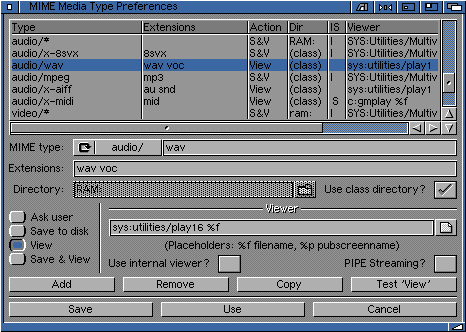
3.8 MIME Preferences

The MIME GUI allows you to set "external viewers" to launch, run, play, view externally, view internally or save to disk, files on the Internet.
You need to tell Voyager what to do when it comes across certain files. For example, if someone had "click here to view this TIF file" how would Voyager show it normally? To view the file you would set a MIME type to recognise the TIF extension when it is encountered.
When you download a file, Voyager needs to know what to do - does it save to file, view it, play it etc. All files have MIME-types. For example a JPG file may have the MIME type of "image" and the sub-type of "JPG", which would normally look like "image/jpg".
Many of the preferences are already allocated for you (which you can change). An LHA file, for example, is already set to "save to disk" as standard.
The beauty of Voyager is that you can set the MIME types to recognise extensions such as a WAV sound file (normally found on a PC) or to play a AVI file (which is an animation file found on a PC or a MAC) when these are found within a web site.
To get Voyager to play a .wav file is relatively easy. Firstly you could get hold of the .wav datatype. Goto the section on the CD and extract the WAV datatype (ftWAV_dt40.2.lha). Install to the correct drawers on your Workbench. You would then use something like "Multiview" to play any .wav files.
In our example we are going to use an external program to play the .wav files. In this example we'll use a program called "Play 16" which is available on the Aminet.
WAV sound files have two different MIME types "audio/x-wav" and "audio/wav" so we need to make two entries within the MIME GUI to be completely secure.
Note the path needs to be complete. ie. it will look similar to "sys:utilities/play16".
Use the function "%f" which indicates filename. ie. Voyager will place the filename
in the position %f (ie. sys:utilities/play16
3.81 Voyager's MIME Pre-settings
Voyager understands and processes HTML and TXT (ASCII text) files internally and displays them within the main window. Voyager's internal image decoders also understand GIF and JPG and will also display these within the main window.
You can get Voyager to recognise other images but these would have to displayed outside the main window. Set your MIME-types to get Viewtek to show a TIF file, for example. Remember that you will need the relevant datatypes to do this!